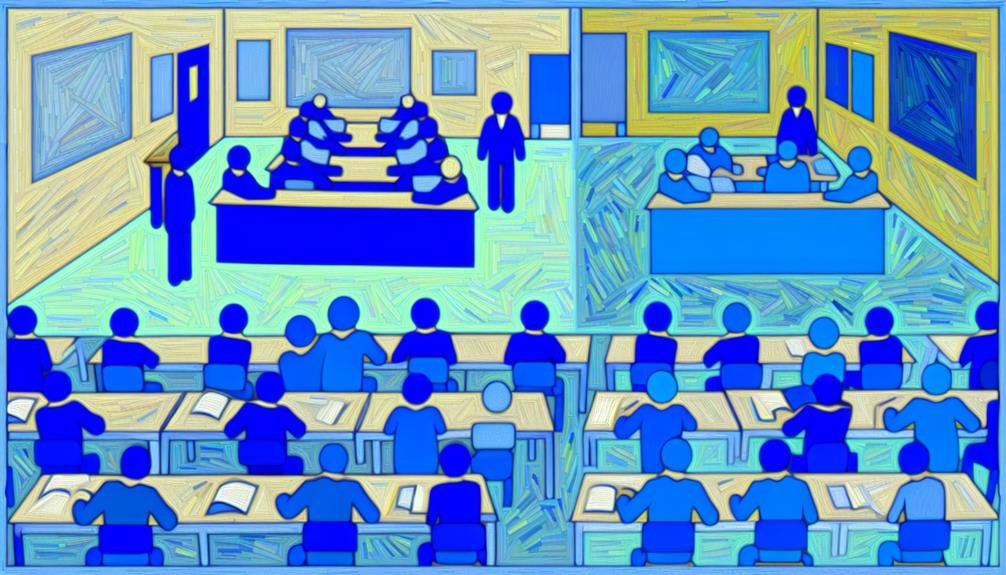Public schools, like a bustling community hub, bring together kids from all walks of life for an epic educational adventure. With Certified Teachers leading the charge, students immerse themselves in a sea of knowledge, while yellow buses dance through neighborhoods, whisking enthusiastic minds to school. Yet, challenges lurk in the shadows: bulging class sizes, limited curriculum flavors, and the occasional bully crank up the drama. Still, public schools, like onions waiting to be peeled, have many layers to explore. So, are you ready to uncover the entire treasure trove that public schools offer?
Takeaways
- Certified teachers provide quality education.
- Government oversight ensures safety and standards.
- Inclusivity promotes diversity and tolerance.
- Limited curriculum options may restrict interests.
- Larger class sizes can hinder individual attention.
Advantages of Public Schools
Public schools, as government-funded educational institutions, offer numerous advantages that contribute to the accessibility and quality of education for students. One significant benefit is the emphasis on the quality of education provided to all students enrolled. Public schools guarantee that teachers are certified, meeting specific teaching standards that enhance the learning experience for students. This dedication to quality education creates a supportive environment where students can thrive academically.
Another advantage of public schools is the focus on Individualized Education. With additional educational assistance and special education classes available, students with diverse learning needs receive tailored support to help them reach their full potential. This personalized approach fosters a sense of inclusivity and ensures that every student’s unique abilities are recognized and nurtured.
Accessibility and Transportation
Accessibility and transportation services play a vital role in making sure that students can easily reach and depart from educational institutions. Public schools, being an integral part of the local community, often offer transportation services to students. Yellow school buses are a common sight, transporting students to and from school with their cheerful yellow hue. These buses not only provide a safe mode of transport but also promote a sense of camaraderie among students as they start on their daily journey together. The physical location of public schools is strategically chosen to cater to students residing within the designated school district, ensuring easy access for all. Government oversight further guarantees that transportation standards are met, enhancing the overall accessibility of public schools. In the table below, let’s take a closer look at the key aspects of accessibility and transportation services in public schools:
| Key Aspect | Details |
|---|---|
| Mode of Transport | Yellow school buses |
| Geographic Location | Strategically chosen within school districts |
| Community Integration | Integral part of the local community |
| Government Oversight | Ensures adherence to transportation standards |
| Convenience | Easy access for students living in the area |
Certified Teachers and Range of Supports

Public schools are like treasure troves filled with certified teachers who bring knowledge and expertise to their classrooms. These educators are armed with an array of support services, ensuring that every student’s unique learning needs are met.
It’s like having a superhero team of teachers and resources all under one roof, ready to empower and uplift students on their educational journey!
Qualified Teaching Staff
With certified teachers at the helm, public schools guarantee a standard of teaching excellence and provide a range of educational supports to cater to diverse student needs. Government regulations ensure that public schools maintain a high standard of teaching by mandating teacher certification. These regulations not only uphold the quality of education but also guarantee that students receive the necessary support for their learning needs. Certified teachers bring with them a wealth of teaching expertise that is essential in creating a dynamic and engaging learning environment for students.
In public schools, the presence of certified teaching staff means that students benefit from a diverse range of educational supports tailored to various learning styles and needs. Whether it’s providing extra help for struggling learners, offering specialized programs like special education, or fostering creativity and critical thinking, certified teachers play an essential role in shaping the educational journey of students.
Their dedication and commitment to student success make public schools an enriching place for learning and growth.
Diverse Support Services
Certified teachers in public schools provide a diverse range of educational supports to cater to students’ varying learning styles and needs. These support services go beyond traditional classroom instruction, ensuring that every child has access to the tools and resources they need to succeed.
From specialized programs for students with learning disabilities to enrichment activities for those who excel academically, public schools offer a wide array of educational support to meet the diverse needs of their student body.
One of the key advantages of these support services is the promotion of diversity within the school environment. By exposing students to different cultural backgrounds and learning styles, public schools create a rich array of experiences that fosters understanding and acceptance.
This diversity not only benefits students academically but also prepares them for the multicultural world they will encounter beyond the classroom walls.
Diversity and Regulation
Diversity in public schools is like a colorful mosaic, weaving together different backgrounds and perspectives to create a rich fabric of learning.
Regulations act as the invisible guardians, ensuring that every student is safe, supported, and given the opportunity to thrive.
It’s a delicate dance between following the rules and embracing the unique qualities that make each student special, creating a harmonious balance of structure and inclusivity.
Diversity Benefits All
Embracing and valuing diversity within public schools not only enriches the educational experience but also fosters a more inclusive and tolerant learning environment for all students. Public schools serve as melting pots, bringing together students from various cultural and socioeconomic backgrounds. This rich fabric of diversity provides students with the opportunity to learn from one another, developing a broader perspective and understanding of different cultures.
Inclusivity is a cornerstone of public schools, where regulations guarantee equal access to education for all students, regardless of their background. Government oversight plays an essential role in maintaining educational standards and supporting inclusivity within these diverse settings.
The vibrant student population in public schools cultivates a sense of community and tolerance among students, preparing them for the diverse world they will encounter beyond the school gates. By embracing diversity, public schools create a dynamic and enriching environment where every student feels valued and accepted.
Regulations Ensure Safety
Government regulations play an essential role in upholding the safety and well-being of students and staff within public schools. These regulations guarantee that safety measures are in place to protect everyone within the school environment.
By promoting diversity, regulations create inclusive spaces that celebrate students from various backgrounds, fostering a sense of belonging and respect among all individuals. Compliance with these regulations is vital as they set standards for facilities, equipment, and educational practices, ultimately maintaining a safe learning environment for everyone involved.
Moreover, safety protocols mandated by regulations help prevent incidents of violence or other harmful behaviors within public schools, creating a secure atmosphere where students can focus on learning and personal growth. By adhering to these regulations, public schools establish a culture of accountability and transparency in their operations, demonstrating a commitment to the well-being of all members of the school community.
Balancing Rules and Inclusion
Finding the right equilibrium between regulatory compliance and fostering an inclusive environment poses a significant challenge for public schools. In the quest to strike that balance, public schools encounter both hurdles and opportunities:
- Inclusion Efforts: Schools work tirelessly to create a warm and inviting atmosphere where every student, regardless of their background or abilities, feels accepted and valued.
- Regulatory Requirements: Governments establish standards to guarantee that all students have equal access to quality education, but these rules can sometimes restrict the school’s flexibility in tailoring teaching methods.
- Diverse and Inclusive School Environment: Public schools celebrate diversity by bringing together students from various communities, fostering a rich mixture of cultures within the school walls.
- Challenges: The real challenge lies in blending these regulatory requirements with the school’s commitment to creating a diverse and inclusive environment that nurtures every student’s potential. Balancing these aspects is key to ensuring that public schools remain safe, welcoming, and conducive to learning for all.
Performance and Consistency

Achieving high standards and promoting academic success, public schools demonstrate a commitment to performance and consistency in education. With a focus on a standardized curriculum, public schools guarantee that all students receive a uniform level of education, regardless of their background. This consistency not only helps in monitoring student progress effectively but also offers stability within the education system. Government regulations play a vital role in maintaining this level of performance, ensuring that public schools meet the teaching standards set by educational authorities.
Moreover, public schools have a proven track record of producing successful graduates, highlighting their dedication to academic excellence. The reliability of public schools is further reinforced by their lower closure rates compared to private institutions, providing families and students with a dependable educational option.
Disadvantages of Public Schools
Public schools endeavor to provide quality education, but certain disadvantages may impact the overall learning environment.
- Larger class sizes: With more students per class, teachers may find it challenging to offer individual attention, leading to potential gaps in understanding and engagement.
- Limited curriculum options: Public schools often offer a standard curriculum, which may not cater to the diverse interests and learning styles of all students, limiting their ability to explore a wide range of subjects.
- Incidents of bullying: Unfortunately, public schools may experience higher rates of bullying compared to private schools, impacting the well-being and sense of safety for students.
- Fewer extracurricular activities: Due to limited resources, public schools may provide fewer extracurricular opportunities, limiting students’ chances to explore their passions outside of academics.
These challenges underscore the importance of addressing issues to create a more inclusive and supportive learning environment in public schools.
Resource Access and Class Sizes

When considering the challenges faced by public schools, the access to resources and the impact of class sizes emerge as significant factors influencing the quality of education provided to students. Resource challenges, such as funding shortages, can hinder the ability of public schools to provide essential tools and materials for learning. This limitation can directly impact students’ educational experiences and opportunities for growth.
Additionally, the larger class sizes often found in public schools can pose a challenge in terms of individualized attention and tailored instruction. With limited access to resources and bigger class sizes, educators may find it challenging to meet the diverse needs of all students effectively.
Furthermore, these constraints can restrict the ability to cater to various learning styles, hindering the potential for a more personalized educational experience. As a result, students in public schools may face obstacles in receiving the level of support and attention necessary for their academic success. Addressing these resource challenges and class size issues is essential for enhancing the overall quality of education in public schools.
Frequently Asked Questions
Are Public Schools Better at Preparing Students for Standardized Tests?
Public schools may excel in preparing students for standardized tests due to a curriculum focus on test content and teaching methods emphasizing exam strategies. However, this approach can lead to student stress, overlooking broader learning goals, and creativity.
How Do Public Schools Handle Students With Special Needs?
Public schools address students with special needs through inclusive classrooms, individualized plans, support staff, accommodations, special education services, and integration efforts. Parents may advocate for appropriate accommodations within the public school system to secure student success.
What Extracurricular Activities Are Typically Offered in Public Schools?
Public schools serve as fertile soil for students’ growth, offering a diverse array of extracurricular activities. From sports clubs to drama programs and debate teams, these institutions provide avenues for social, intellectual, and physical development.
Can Parents Volunteer in Public Schools to Help Support Education?
Community involvement and parent engagement are fostered through volunteer opportunities in public schools. Parents can provide valuable classroom assistance, educational support, and strengthen school partnerships. Training and orientation are often provided to guarantee effective contributions to student learning.
Do Public Schools Provide Mental Health Resources for Students?
Public schools offer a range of mental health resources for students, including counseling services, support groups, mental health awareness programs, prevention initiatives, peer mentoring, and stress management activities. These resources aim to support students’ emotional well-being and address mental health concerns.
Conclusion
To sum up, public schools provide a wide range of benefits such as accessibility, certified teachers, and diversity. However, challenges like resource access and class sizes can hinder the overall experience.
Like a colorful mosaic, public schools bring together different pieces to create a vibrant and dynamic learning environment. It’s important to weigh the pros and cons carefully to make the most out of your educational journey.

